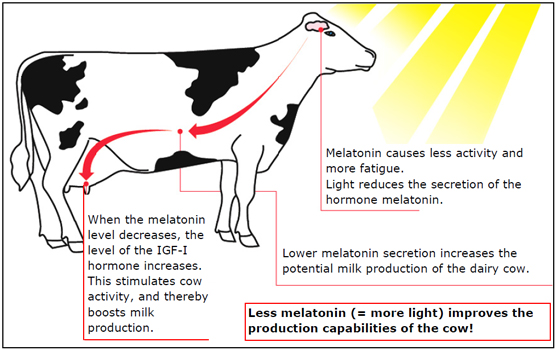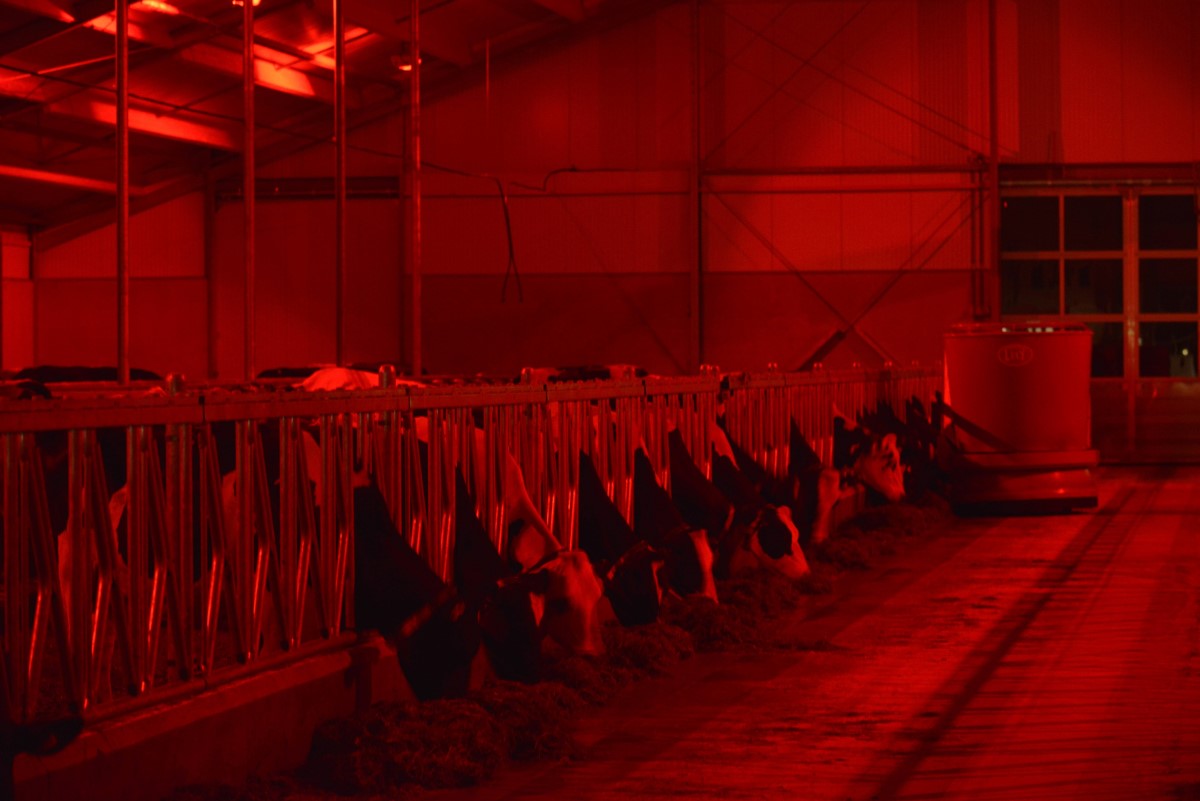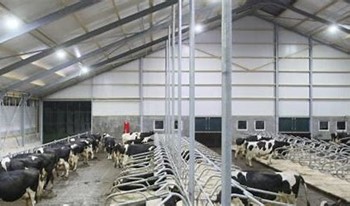Cattle Shed Lighting
1 September 2023As the price of electricity has increased, spending time re-evaluating your current lighting situation as we head towards winter can help reduce the electricity bill. This report will focus on the use of lighting in cattle sheds, it includes information for both beef cattle and dairy cattle. Lighting is important in the farming industry due to the influence it can have on cattle e.g. increased milk production, fertility and dry matter intakes (DMI) in cows.
Lighting Choice and Maintenance
Lights should always be switched off when not in use. Metal halide lights are one of the most energy efficient types to be using on farms although they do cost more than average, high pressure sodium lights have a 10% longer life as well as low maintenance although they are a yellow light so may not be everybody’s preference. Although when choosing your lighting it is important to think about spending more money on the actual lighting bulbs as they will save you money in the long term.
Maintaining the lighting in your shed is vital as any damage or cobwebs may affect its overall performance meaning you won’t get the best out of your lights. Regular checks of the light lux reading should be taken to ensure that the lights aren’t losing lux over their lifespan. The recommended lux for cattle sheds is between 160 – 200 lux.
Table 1 shows the advantages and disadvantages of certain lights. The main lighting choice on farm is LED due to their longer lifespan, energy efficiency whilst generating less heat and are usually less maintenance.
Table 1. Types of Lighting
| Type of light source | Technical aspects | Advantages | Disadvantages |
|---|---|---|---|
| Light bulb | 10-15 Lumen² per watt | Low cost | Short life expectancy |
| Neon | Life expectancy: 8000 - 10000 hours; production 60-85 lumen/watt depending on type | Low investment. White light fast glow | Effected by temperature |
| Sodium vapor lamp | Life expectancy: 24000 hours with 10% reduction of light emission after 10000 hours | Yellow light | Not liked by every customer |
| High pressure sodium lamps | Life expectancy: 24000 hours with 10-15% reduction of light emission after 10000 hours. Producing 132 lumen per watt | Yellow light | Not liked by every customer |
| Metal Halide lamps | Life expectancy: 10000 hours with 15-30% reduction of light emission after 10000 hours. 95 lumen per watt | White light which may be a personal preference | Expensive |
Source: Lighting effects in dairy cow housing, Teagasc
Shadows and Brightness
Research has shown that cows have difficulty identifying objects when there are shadows or lighting intensities are differing across the shed. Studies have suggested that injuries may be more common in environments that have many shadows due to impaired vision when the cow is unable to clearly identify the hazard.
The angle at which lighting is placed at is also significant as the further away you place the light the less impact the light will have, although having lighting too close to the ground or angles to the side can cause shadows that can cause cows to be put off going to a certain area. It is recommended that lights should be at a 120 degree angle and are out of reach of being in contact with the roofs or machinery.
In the parlour, the lights need to be bright as the milkers need good lighting to see what they are doing in the pit, although lighting needs to be monitored as any shadows in the pit can put certain cows off coming in to be milked. The lux of the lights in the parlour should be around 50 lux, so over double the lighting lux in the housing sheds. The lighting in the main sheds/housing sheds needs to be monitored and adapted to suit the cows/farmers as a change in lighting can easily put cows off feeding from a certain area or using certain cubicles e.g. shadows, dark corners.
Timings
Some farmers have the lights on a timer system meaning they are only on for the minimum time possible, which can help with saving money on electricity. Having lights on timers also means the cows are getting the exact same amount of light every day, meaning they will get into a routine of when the lights go on and off.

On average cows need at least 8 hours free of light (darkness) to get enough rest. It has been proven with research that the right amount of lighting can increase a dairy herd’s milk production by 6-15% on average, between 1,000 - 2,000 litres per cow, per lactation. Leaving bright lights on 24/7 can have a negative effect on your livestock since as well as not having appropriate time to rest and sleep, bullied cows may not get the chance to access silage/water. When the lights are constantly on it means the more dominant cows will be more alert or will be more inclined to move around and eat whereas if the lights are off for at least 8 hours the less dominant cows will have a chance to get into the feed/silage while the more dominant cows are resting.
Having the right amount of brightness in the farm sheds can make a big difference, when the cows are resting it is important for the brightness level of the lights to be below 50 lux. For both dairy and beef cows it is recommended that they have at least 16 hours of light and 8 hours darkness. Having the lights on for set amounts of time encourages beef and dairy cows to maximise their dry matter intakes. The amount of darkness calves need differs to cows as they require more time for lying down and sleeping - newborn calves sleep for around 16 hours a day and require less sleep as they get older. Dry cows given the opposite light regime of the milking cow (16 hours in darkness and 8 hours in light) have been known to let out more milk than in their previous lactations.
When building a shed for cattle, it is important to always make sure that the lighting is taken into account at the planning stage. Trying to optimise the amount of natural light getting into the shed should always be a priority. Using as much natural lighting as possible is not only beneficial to the famer but also to the cows due to ventilation and natural lighting being linked.
Red Lighting

Source: Barn lighting – energy saving, Lely
Due to dairy cows being a 24/7 operation, there always needs to be light available, particularly if the herd are being milked three times per day. Red lighting gives the farmer the opportunity to check the cattle without bothering them too much with the brightness of normal lighting or torch lights. The cows hardly recognize the red lights with no effect on the cows’ perception of the dark therefore meaning they can still get their 8 hours of resting.
Red lighting also has other benefits such as security, due to the lights being on it may put off thieves if they think somebody is around as well as the security cameras being able to see better with the additional red light rather than pitch black. Red lighting also gives an aspect of safety, as the farmer can see all his livestock and can be aware of any that can be unpredictable when walking through the housing sheds.
How Many Lights are Needed?
The calculation for working out how many lights are needed in a shed is as follows –
“Square footage of shed x FC x K Divided by the Lumen output per lamp.”
FC = Minimum intensity needed for the light period, around 15-20 units.
K = amount of light that can escape from the shed e.g. open sided shed (3), closed barn (2).
An example of a calculation would be if the shed was 10,000 square foot, open sided, 250 watt/20,500 lumen, metal halide lights it would mean that the shed needs 22 lights for the shed to make it as efficient as possible.
Top Tips
- Remembering to turn the shed lights off when not in use or in daylight to save money on electricity.
- Investing money into buying the right lights for your shed can be beneficial in the long run.
- Cows need at least 8 hours of darkness for rest and 16 hours of daylight/in light.
Laura MacGregor & Dr Cara Campbell, SAC consulting
Sign up to the FAS newsletter
Receive updates on news, events and publications from Scotland’s Farm Advisory Service

